Last Update: September 2, 2015
What if we collectively take no action to address climate change and other environmental problems from the fossil fuel industry? We’ll have collectively saved gobs of money by not investing in clean energy technologies, without doing any mitigation. Instead we’ll have kept on buying supposedly cheaper fossil fuel powered machines, and continue experiencing the full effects of fossil fuel consumption.
We as individuals can choose to buy fossil fuel powered machines, or electrically powered ones. Where the impact of an individual choice is small, the sum average of all our choices taken together is the concern. It’s what we collectively choose to do that will determine whether climate change (or other environmental problems) are a seriously bad issue, or not.
Buying fossil fuel powered machines is the path of least resistance, because it’s what “we” (collectively) have always done. The society around us is configured to support fossil fuel powered machines and make them the default choice.
That makes buying fossil fuel powered machines the path of inaction. It’s the path in which you’re making zero change from “business as usual”.
Corporations and governments when design the policies for the society we live in. Those policies influence our individual choices one way, or another. Choices are made every day to continue investing in the status quo (no change), or to switch investment dollars over to the new paradigm that dispenses with fossil fuels.
What’s the cost of inaction? Put another way, what’s the cost of business-as-usual?
A number of reports from climate scientists indicate our “business-as-usual” future is very bleak. We’ll experience more extreme weather, food shortages, rising sea levels, massive forest fires, and so on.
The primary avenue to learn about the majority conclusion of climate scientists is the reports published by the
Intergovernmental Panel on Climate Change. Their job is to synthesize climate science papers into a series of combined reports released every couple years. The Fifth Assessment Report (AR5) was published during 2013-2014.
These reports contain the consensus assessment from thousands of scientists around the world as to what will happen in a range of scenarios, including the business-as-usual scenario where no significant change is made.
The political climate has made it appear scientists have lots of doubt about climate change predictions. According to
NASA’s Global Climate Change information website, over 97% of climate scientists, and dozens of scientific institutions from around the world, are in agreement on the dire predictions of future problems arising from the changing climate. In what universe does 97% agreement mean “Lots of Doubt”?
Because of the political climate, let’s start with the beginning – anthropogenic CO2 emissions, meaning human-caused CO2 emissions and the fact that humans are causing the climate to change.
Changing Direction?
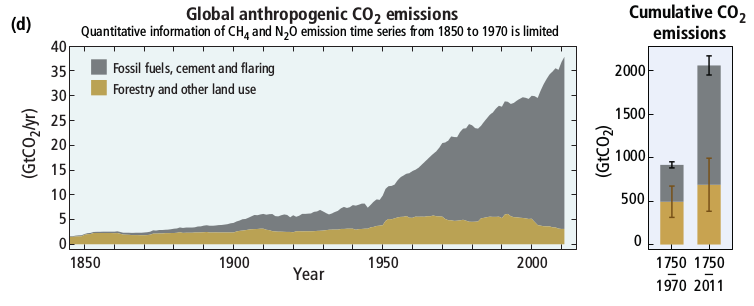
This chart shows a large up-tick, starting around the end of WWII, in the rate of human-caused CO2 emissions. During the same period the rate of CO2 from human forestry operations went down even though the population went up considerably, as well.
This time period contains the rise of the modern globalized society we now live in. A society fueled by flagrant fossil fuel consumption.
Fossil fuels gifted us with the fuel for the machines which enabled us to routinely travel around the world, ship stuff between continents as a matter of course, to demolish mountains, to dig huge tunnels, and more.

During the same time period of this massive uptick in human caused CO2 emissions, saw increased CO2 concentration in the atmosphere. (Green line is CO2, orange line is Methane, and the red line is Nitrogen-Oxide, all of which are closely associated with fossil fuel consumption)
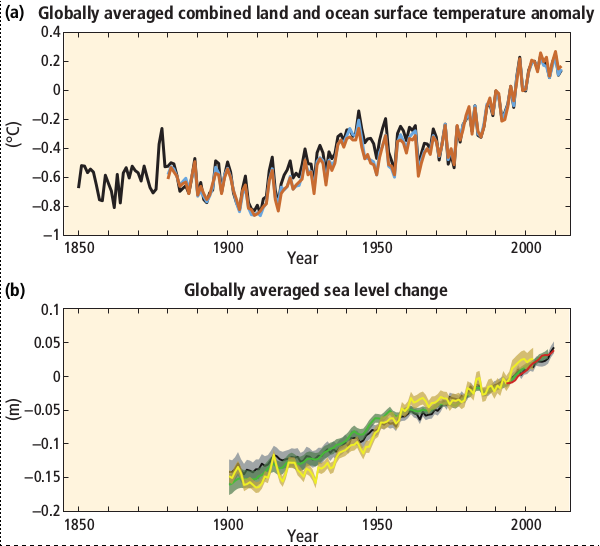
The assertion made by climate scientists that certain gasses – CO2, Methane, etc – act to trap heat. The greater the concentration of greenhouse gasses the higher the temperature. The higher temperatures cause certain effects, including melting of ice that’s then causing sea level rise.
These charts have strong correlation with one another. Increased CO2 emissions, increased CO2 concentration, temperature increases and sea level, all rising together.
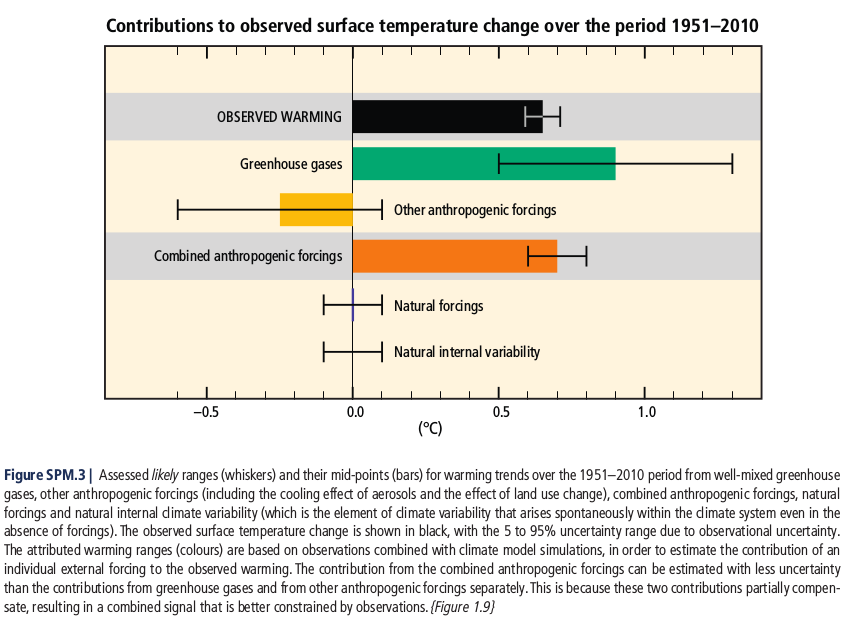
One of the naysayer comments about human-caused climate change is that the planet goes through cycles on its own, and maybe the CO2 increases are due to a natural process.
This chart shows that natural CO2 emissions are a pipsqueak compared with human caused CO2 emissions. It also shows that there is human-caused cooling as well as human-caused heating. Notice that subtracting the anthropogenic cooling effects from the anthropogenic heating effect from greenhouse gasses, roughly equals the observed warming. In other words, the planet could be getting hot faster than it is now if it weren’t human-caused cooling.
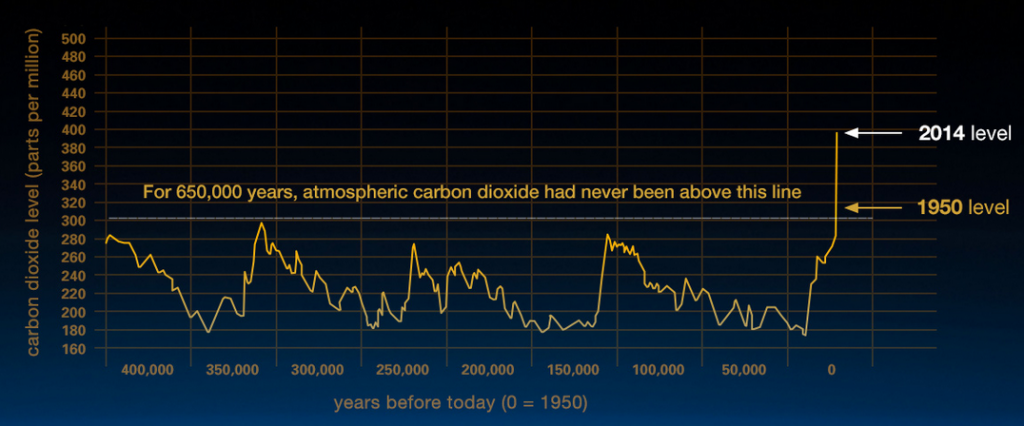
It’s also possible to look back over a longer period of time than the last few decades when human scientists had the ability to measure CO2 concentrations in the atmosphere. Is the current CO2 concentration (just over 400 parts per million) in line with natural variations? The last few decades of direct CO2 measurements aren’t enough data to answer that question.
However, ice cores from, say, Greenland or Antarctica contain samples of ancient atmospheric conditions. As glaciers form they trap air bubbles containing the atmospheric conditions of that era. By taking ice core samples, scientists have been able to track variations of atmospheric carbon dioxide over time. And by correlating atmosphere samples with other data, they’ve been able to get a long range picture of temperature and CO2 concentrations over a significantly long time period – 650,000 years.
This data shows that over the last 650,000 years atmospheric carbon dioxide never went over 300 parts per million.
We just passed 400 parts per million, and this graph shows the trajectory is “straight up”.
Therefore, our future is an atmosphere make-up completely unlike what’s known from the geological record.
To reiterate, atmospheric CO2 concentration is directly related to global temperature increases. CO2 concentration levels is going “straight up”. What does that say about future temperature increases?
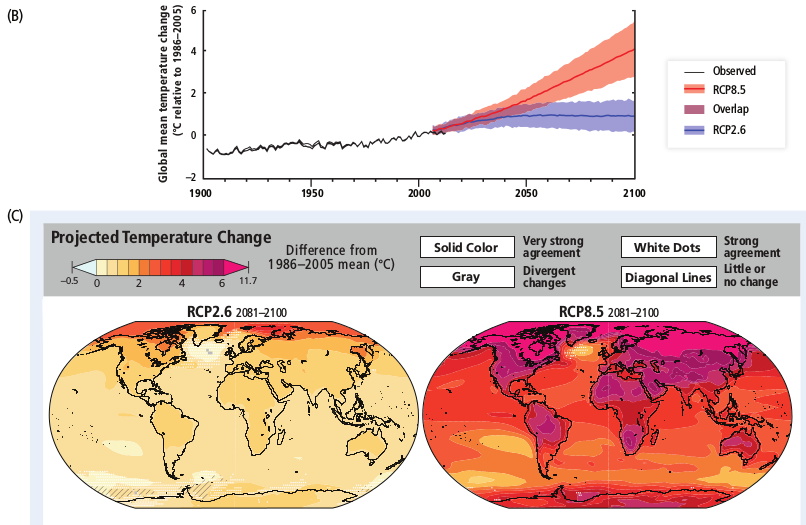
What we collectively (and individually) choose to do affects the outcome. Our collective choice over the past several decades resulted in the climate predicament we’re facing. We can collectively choose a different direction.
This chart shows alternate scenarios that are possible, and the expected temperature of the planet that will result. The RCP8.5 scenario assumes maintenance of high greenhouse-gas emissions, essentially taking no action to change anything. The RCP2.6 scenario instead assumes quite a bit of effort put into reducing greenhouse gas emissions.
The RCP8.5 scenario is expected to be much much much much hotter than the RCP2.6 scenario.
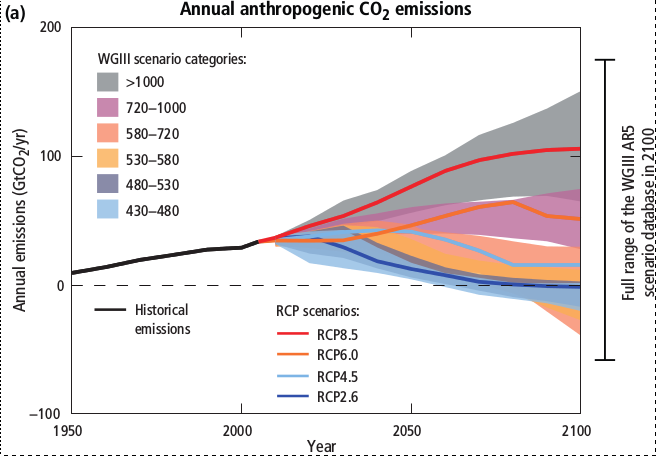
There is a range of these scenarios between RCP2.6 and RCP2.8. Depending on the path we actually choose, we’ll end up either with continued high CO2 emissions or low CO2 emissions or somewhere in-between.
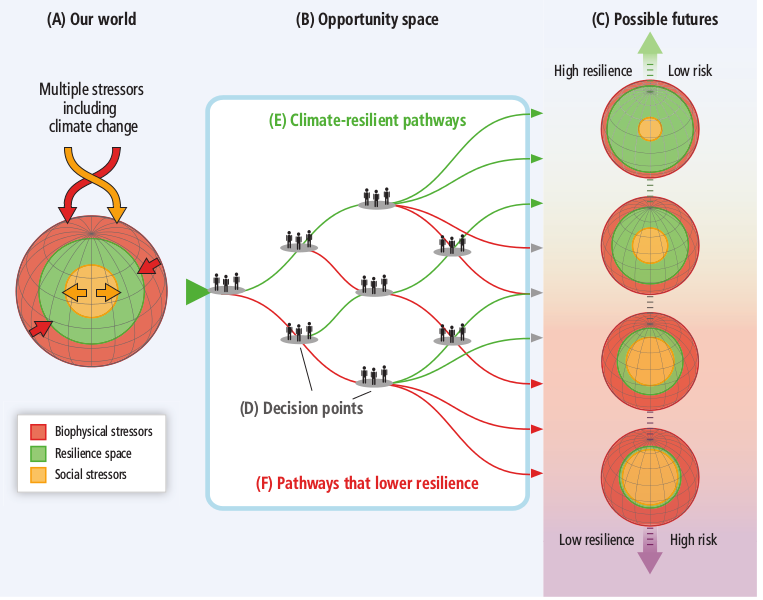
It’s our choices – collectively and individually – that will give us one result or another.
We can choose to continue flagrant fossil fuel consumption. Doing so will continue increasing CO2 concentrations in the atmosphere. But, the previous charts showed there is a strong correlation between CO2 concentration and global temperature and sea level rise.
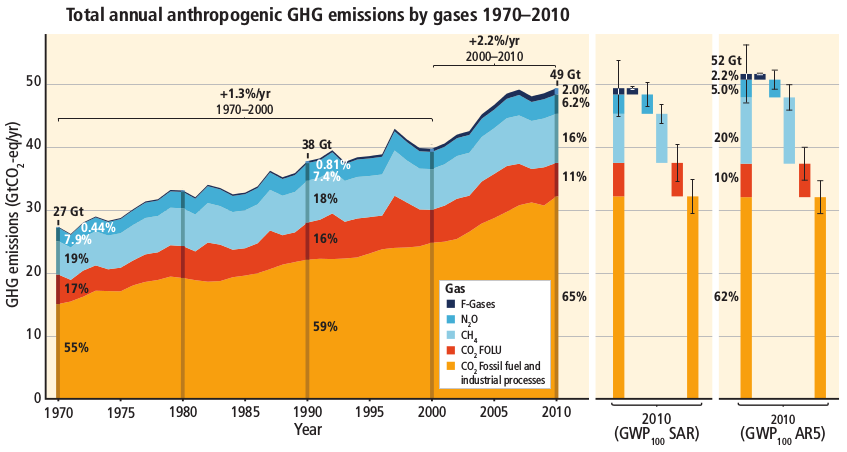
How much impact can be made by individually and collectively switching to electric vehicles?
What’s shown here is that “transportation and industrial” sources of CO2 emissions are growing rapidly, and in 2010 accounted for 65% of total CO2 emissions.
Therefore, the “transportation and industrial” sector is the highest priority source of CO2 emissions to reduce. To make a big difference means switching all kinds of transportation vehicles to electric drive, not just our cars.
What about the cost of inaction?
At the top I said there’s a cost of inaction, then showed you a bunch of charts. Now it’s time to go over what’s likely to happen if we don’t change direction.
Those charts made the case that climate change process is happening, and is extremely likely to cause the negative effects predicted by climate scientists. The charts demonstrate that the CO2 emissions from human activity are a known quantity, and that the matching effects in the atmosphere and the climate means our future is scary.
We’ll go over the IPCC report (IPCC Climate Change 2014, Impacts, Adaptation, and Vulnerability, Summary for Policy Makers) in more detail in this section. Many say the IPCC reports are downplaying the expected impacts, so while the following predictions are pretty extreme keep in mind that the coming decades could be far worse than the IPCC predicts.
First, the process is already underway. There are apparent changes which already are impacting us from deadly heatwaves, to it being the “hottest year on record” for year upon year, to the increased rate of extreme storms, to extreme drought in other areas, and so on.
Glaciers are shrinking away at an alarming rate. In many areas there’s no rain during the summer, and people living there have, for thousands of years, relied on glacier melt for water. But when the glaciers disappear, there’s no glacier melt, and you have a water crisis. Such as the drought crisis unfolding in California.
It’s mid-2015 as this is written, and Gov. Brown announced today a historic measure to cut water supplies to farmers. The measure gets us to our next point – a world food supply crisis. The California example will play out in similar ways around the world. Shrinking water supply means California has limited choices of allocating water and powerful interests that have enjoyed unfettered water access for decades. California’s agriculture industry ships food all across North America, even though most of the state is nearly a desert. Modern agriculture practices is completely unnatural, and relies on pouring chemicals and water upon soil to make up for lack of soil nutrients and sound land management practices. Cutting back water will have a devastating effect on California’s agricultural production, which in turn will have a large impact on the whole U.S. food supply since so many foods are grown in California.
Coastal areas will be flooded from extreme storm surges in extreme storms, and from simple sea level rise. This is expected to cause deaths, injuries, illness, disrupted livelihoods, destruction of coastal infrastructure (highways, ports, airports, bridges) as well as submerging whole islands in some cases. Breakdown of infrastructure like highways, bridges, electrical grid from flooding and other extreme weather events.
Humanity has built lots of expensive high value objects on the coasts. This includes airports, bridges, highways, seaports, cities, concert halls and more. With 20 feet of sea level rise (or so) expected over the next few decades, how many of those will survive? Some forward thinking cities plan to build seawalls, but how high can those be built?
Deaths and morbidity from extreme heat, especially those who have to work outdoors.
Risk of food insecurity and breakdown of food systems, due to warming, drought, and flooding. Loss of income for rural areas, again due to limited water supply and increasing difficulty with growing crops or livestock.
Loss of marine seafood, a major source of protein around the world, because of over-fishing, ocean acidification, and warming of the oceans. The changing climate, combined with other stressors like habitat modification, over-fishing, pollution and invasive species, will cause an elevated extinction rate for all kinds of marine life. For years now the prediction has been that by 2050 there will be no remaining large fish in the ocean, and the effect will be like having wiped out a half billion years of evolution.
Ocean Acidification is especially hard on corals, mollusks, and other sea-life that are important for the web of life.
Urban climate change risks include items like heat stress, extreme rainfall, extreme storms, flooding, landslides, and in other areas extreme drought will dry up food and water supplies.
These changes will cause whole populations to desire to live elsewhere, creating what will be called “climate refugee’s”. Usually refugee’s move to escape a war, but increasingly they’ll be escaping unbearable living conditions.
Widespread war as countries fight each other for resources.
Summary
In short – climate change is being caused by human activities, especially burning fossil fuels.
If we don’t make any change, if we follow “business as usual”, our future is bleak. We’re already seeing climate refugees, and wars over ever-scarcer resources, and it’s expected future wars will be even worse.


